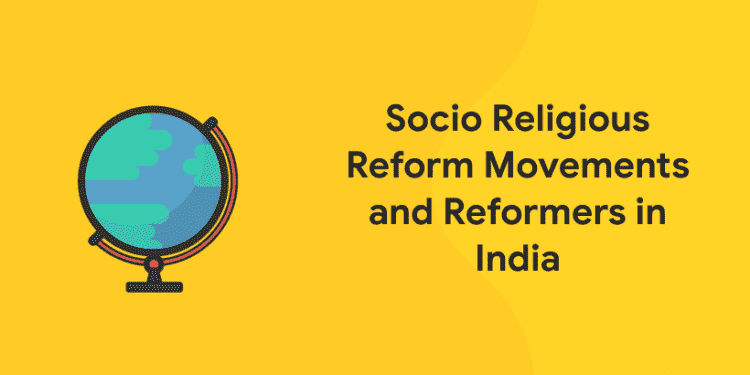Table of Contents
Humans are flawed in many ways and we must embrace our flaws to make them our strengths. However, these flaws in human nature have seeped into society and its functioning numerous times in the past and present. But, where there is evil, there is good. Throughout history, many Socio Religious reformers have existed and brought about reform movements in the workings of the society in India. These reformers are role models to look up to. In this article, we will bring to light the various reformers and their landmark reforms.
Attempt free GK mock tests! Download the Entri App Now!
Socio-Reformers and their Reforms
Here is a list of a few important Socio Religious Reformers and their reform movements in India. So read on and find out.
Get daily current affairs updates! Download App Now!
Raja Ram Mohan Roy
Raja Ram Mohan Roy is one of the most well-known social reformers in India. He has accomplished several feats. However, his greatest achievements involve the setting up of Brahmo Samaj. Brahmo Samaj believed in the fatherhood of God and brotherhood of mankind. It not only discarded meaningless rites and rituals but also forbade idol-worship. Raja Ram Mohan Roy preached Monotheism in Hinduism. He was one of the earliest feminists in Indian society. He preached unequivocally for women rights and was crucial in the abolition of Sati. Rabindranath Tagore referred to him as the ‘Father of Indian Renaissance and the Prophet of Indian Nationalism’. Ram Mohan was an editor in the Sambaed Kumauni and MiratuI Akbar (2 famous newspapers).
Ishwar Chandra Vidyasagar
Ishwar Chandra Vidyasagar is an important reformer. He was a Bengali educator and reformer and was also a key figure in the Bengal Renaissance. The spirit of self-sacrifice, simple living and fearlessness guided him. He wrote a Bengali primer, Barna Parichaya which is still in use. His greatest contribution was his advocacy for education of women and rights for widows. A law was passed which made widow remarriage legal through Widow Remarriage Act (1856) and this was due to his efforts.
Attempt free mock tests! Download App Now!
Swami Dayanand Saraswati
At the age of 14, he rebelled against the practice of idol worship. The Satyarth Prakash was his most important work. He preached directly to the masses and did not confine his teachings to intellectuals. He started the Suddhi Movement to bring back the Hindu converted to other religions and played some role in the growth of communalism in the 20th century. It played a progressive role in the field of national awakening by attacking religious superstitions, polytheism and the supremacy of Brahmins. In 1875, Swami Dayanand Saraswati founded the Arya Samaj in Bombay.
Swami Vivekananda
Swami Vivekanada was a very prominent figure whose accolades have resulted in educational institutions being named after him. He founded the Ramakrishna Mission in 1896. The work done by the Ramakrishna mission included humanitarian and social work to all without any distinction. It was mainly to help the poor and destitute. The basic motto of the mission was to provide social service, spread the meaning of Vedanta spiritualism and strive for harmony among various faiths and cults. This motto has become the center of various public and societal welfare institution.
Get Weekly Current Affairs on the Entri App
Debendranath Tagore
He founded the Tattvabodhini Sabha in 1839 to facilitate discussions on different philosophies. He also published Tattvabodhini Patrika. Tattvabodhini Sabha amalgamated with the Brahmo Samaj in 1859. Also, he had compiled selected passage from the Upanishads, which known as Brahma Dharma. As the influence of Brahmoism spread throughout India under his leadership, he established himself as a person of particular spiritual accomplishment and came to be known as ‘Maharshi’.
HP Blavatsky
The Theosophical Society was started by Madam Blavatsky. She started Theosophical movement in New York with Col HS Olcott. They arrived in India in 1879 and established the headquarters of the society at Adyar near Madras in 1882. Theosophist popularized the study of oriental classics, especially Upanishads and Bhagwat Gita. Annie Besant became the leader of the movement. In 1865, The Veda Samaj was established. It preached against caste distinction and promoted widow remarriage and women’s education. Kandukuri Veeresalingam started a Telugu journal in 1876 which was exclusively devoted to social reform. Shri Narayan Guru worked for the improvement in the condition of the backward and oppressed sections of the society.
Get weekly Current Affairs updates on the Entri App
Annie Besant
She joined the Theosophical Society in England in 1889 and came to India in 1893. Then she went on to become the President of the society after death of Olcott in 1907 and she had also translated the Bhagwat Gita in English. Later, she laid the foundation of the Central Hindu College at Banaras in 1898 that later became nucleus for the formation of Banaras Hindu University in 1916.
Conclusion
These were some of the famous socio religious reformers and their reform movements in India. They have worked extensively to eradicate the prejudices, injustices and biases that existed in our society. There are many more such reformers but to compile a list of all of them would be near impossible. However, all of them contributed to the welfare of the society in whatever way they could. Society shall strive to be the best version of itself. The knowledge of these reformers are required in various competitive exams. To help you in the other aspects of the exam, Entri App is your best companion. It contains tons of mock tests and quizzes. You can learn about various topics like the history of banking in India. Click here to view. There is no time like the present to dedicate your time to preparations. Good Luck.
Ace your preparation for competitive exams! Download App Now!












